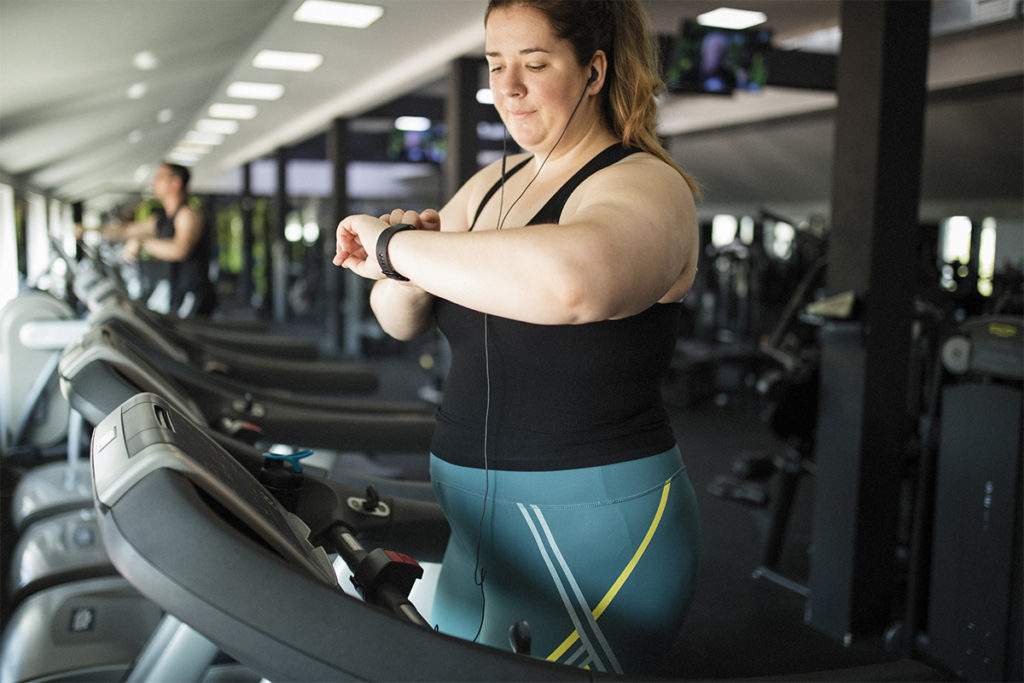What Makes Bone Adapt: Gravitational Forces or Muscle Loading?
A review of the research settles the conundrum—or does it?
Exercise professionals regularly exclaim the benefits of exercise for maintaining and improving bone mineral density and bone health. They describe the benefits of gravitational weight-bearing exercise (i.e., ground-impact activities, such as walking, running and jumping) and muscle-loading activities, such as weight training. However, scientists are currently debating which exercise intervention provides more beneficial bone health adaptations.
One of the major goals of exercise, as we project and plan for our aging exercise enthusiasts, is osteoporosis prevention. Are the impact forces from gravitational-force activities (i.e., contact of the body with the ground) the key factor that stimulates bone growth, or is it the bone-loading mechanisms from muscle (i.e., the contractile forces from muscle through the tendon to bone) that provide the better stimulus?
No study has unequivocally demonstrated that either gravitational or muscle forces impart the dominant growth-promoting effect on bone. Recently, Medicine & Science in Sports & Exercise published a series of articles exploring this debate, which will be highlighted in this column, along with descriptive details about how bone builds, remodels and breaks down.
Bone Basics 101
Bone is clearly one of the most essential, intricate and interesting organs of the human body. It is affected dramatically by physical activity, nutrition and life changes such as menopause. It serves as a reservoir for calcium, with 99% of the body’s calcium residing in the bones and teeth. The remaining 1% is found in the blood and interstitial fluids (the liquid found between the cells of the body) (Taylor & Johnson 2008). The 206 bones in the adult human skeleton provide structural support for the muscles to attach to and protection for all vital organs, including the spinal cord, brain, heart and lungs.
Bone in human and other mammal bodies is generally classified into two types: trabecular bone, also known as cancellous bone, and cortical bone, also known as compact bone. Trabecular bone makes up the interior of bone and has a spongy construction. It has many blood vessels and contains red bone marrow, where the production of red blood cells occurs. Cortical bone is the outer shell of bone and is a much denser, stronger and stiffer osseous (bone) tissue than trabecular bone.
Bone renews itself through a process called bone remodeling, which involves two phases—formation and resorption. Bone tissue formation is also referred to as ossification. Ossification is the process by which cartilage, which is relatively soft, transforms into hard bone (as during infant and child development). Bone resorption is the process by which osteoclasts (specialized cells that secrete enzymes that dissolve bone) break down bone and transfer calcium, magnesium and phosphate products from bone fluid to the blood. Bone resorption can also be the result of disuse and lack of stimulus for bone maintenance; thus, preventing excessive bone resorption is one of the major physiological reasons for promoting regular exercise. During childhood, bone formation exceeds resorption, but as people enter their 40s and 50s, resorption exceeds formation (National Institute on Aging 2009).
Regulating Bone Health
Vitamin D, which is primarily absorbed from sunlight through the skin, becomes biologically activated in the kidneys to form calcitriol, which helps bones absorb calcium from the blood. Calcium binds with phosphorus (a dietary mineral) to form calcium phosphate, a mineral that helps form and strengthen bones. The kidneys also excrete phosphorus, which assists in balancing calcium levels in the blood. Thus, if kidney function becomes impaired, bones may not get enough calcium, either because the kidneys fail to turn vitamin D into calcitriol or because they allow too much phosphorus to build up in the blood.
The parathyroid gland (which is actually four small glands located behind the thyroid gland) regulates how much calcium is secreted by the kidneys as well as how much calcium the bones store. For instance, if blood calcium levels drop below a certain point, specialized calcium-sensing receptors in the parathyroid gland are activated to direct the kidneys to release more calcium. Estrogen helps the parathyroid glands keep calcium levels in balance. The drop in estrogen levels at menopause leads to greater bone resorption and loss of bone tissue in females. In men, testosterone plays an important role in bone maintenance and formation through a complex interaction between testosterone and other hormonal receptors. Thus, for men, a low testosterone level is a risk factor for developing osteoporosis.
The Debate:
Gravitational Forces
Versus Muscle Loading
A clear scientific answer on what stimulus most favorably affects bone adaptation would help fitness professionals design optimal exercise programs. Beck (2009) observes that a perplexing and unresolved issue is that, in computer modeling studies, “introducing” and “removing” muscle-loading forces during gait activities have both been shown to positively influence bone growth. In other words, in weight-bearing activities, muscles may impart additional loads on the long bones of the legs or counteract the gravitational forces being placed on the bone.
Judex and Carlson (2009) state that this controversy regarding the effects on bone of gravitational forces versus muscle loading stems from the fact that scientists don’t fully understand the series of signals that occur in a skeletal segment to promote bone growth. However, Robling (2009) notes that research does know that it is fluid shear forces (forces of fluid parallel to material in cells) within bone cells and not the mechanical stretch of the bone cells that appear to elicit bone growth from exercise. In addition, Judex and Carlson state that during many exercise movements the forces from gravity and muscle (going through concentric and eccentric contractions) are dynamically changing, and therefore separating the contributions of both forces is not possible. The authors add that this controversy cannot be cleared up simply by measuring which force provides the greatest load (or strain) on bone. In fact, Judex and Carlson note that bone growth is very sensitive and responsive to different patterns of muscle force recruitment and various speeds of force and contraction from the exercise movement.
Importantly, from a health perspective, Kohrt, Barry and Schwartz (2009) emphasize that there is convincing evidence that being physically active lowers the risk of hip fracture dramatically (see the sidebar “10 Facts About Hip Fractures, Falls and Osteoporosis”).
The Bone Bottom Line
Considering the interdependence of gravitational and muscle-loading forces on bone, which is more effective for strengthening bone just may be a scientific question that remains unresolved. The literature provides favorable evidence for both muscle forces and gravitational loading for skeletal bone adaptation. It also appears from this scientific review that there is no one specific dose of exercise that appears to be best for bone adaptations. In fact, the research appears to suggest just the opposite. Exercise professionals may best benefit clients’ bone-strengthening adaptations by incorporating different gravitational activities (walking, running, jumping, stair climbing, etc.), with different muscle-loading environments (on land and in water), at various speeds (slow, moderate and explosive) and with varying resistance training load (moderate to high) plans.
Help your clients prevent bone “theft” by incorporating all of the strategies and systems currently being employed in successful periodization programs. Aerobic and resistance training design may be the optimal exercise solution for improving bone strength and reducing the risk of
osteoporosis and hip fracture.
1. In Moayyeri (2008), moderate-to-vigorous physical activity was associated with a hip fracture risk reduction of 45% in men and 38% in women.
2. Falls occur most commonly when subjects are walking or going up and down stairs.
3. Fifty percent of all women and 33% of all men will have a bone fracture during their lifetime.
4. Osteoporosis affects more than 200 million women worldwide.
5. The annual healthcare costs of osteoporotic fractures in the United States are estimated at $7–$10 billion.
6. Fracture risk is primarily determined by three factors: risk of falling, bone strength, and force of impact during the fall.
7. Established risk factors for falling are older age, impaired balance, impaired vision, decreased reaction time, weakness in lower-extremity muscles, loss of muscle mass, impaired mobility and orthostatic hypotension (low blood pressure occurring in some people when they stand up).
8. Sedative medications, alcohol intake, inappropriate footwear and physical factors in the environment (such as stairs, lighting and uneven street surfaces), are also risk factors for falling.
9. The risk of hip and wrist fractures is thought to be influenced by both the tendency to fall and a loss in bone strength.
10. Vertebral fractures have not been causally linked to falls and appear to be more related to a loss in bone and muscle strength.
Source: Moayyeri, A. 2008. The association between physical activity and osteoporotic fractures: a review of the evidence and implications for future research. Annals of Epidemiology, 18 (11), 827–35.
References
Judex, S., & Carlson, K.J. 2009. Is bone’s response to mechanical signals dominated by gravitational loading? Medicine & Science in Sports & Exercise, 41 (11), 2037–43.
Kohrt, W.M., Barry, D.W., & Schwartz, R.S. 2009. Muscle forces or gravity: What predominates mechanical loading on bone? Medicine & Science in Sports & Exercise, 41 (11), 2050–55.
Moayyeri, A. 2008. The association between physical activity and osteoporotic fractures: A review of the evidence and implications for future research. Annals of Epidemiology, 18 (11), 827–35.
National Institute on Aging. 2009. Osteoporosis: The bone thief. www.nia.nih.gov/HealthInformation/Publications/
osteoporosis.htm; retrieved Jan. 4, 2010.
Robling, A.G. 2009. Is bone’s response to mechanical signals dominated by muscle forces? Medicine & Science in Sports & Exercise, 41 (11), 2044–49.
Taylor, A.W., & Johnson, M.J. 2008. Physiology of exercise and healthy aging. Champaign, IL: Human Kinetics.
Len Kravitz, PhD
Len Kravitz, PhD is a professor and program coordinator of exercise science at the University of New Mexico where he recently received the Presidential Award of Distinction and the Outstanding Teacher of the Year award. In addition to being a 2016 inductee into the National Fitness Hall of Fame, Dr. Kravitz was awarded the Fitness Educator of the Year by the American Council on Exercise. Just recently, ACSM honored him with writing the 'Paper of the Year' for the ACSM Health and Fitness Journal.






